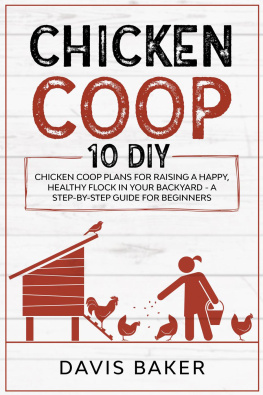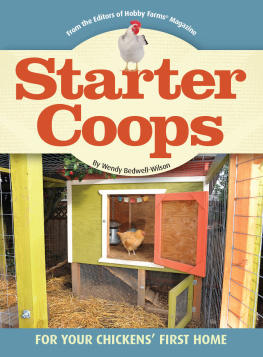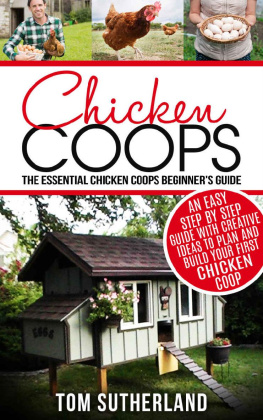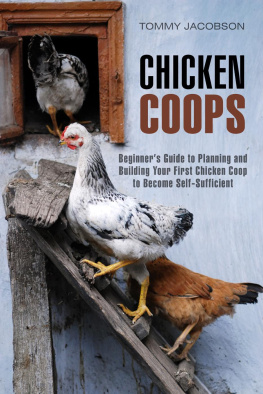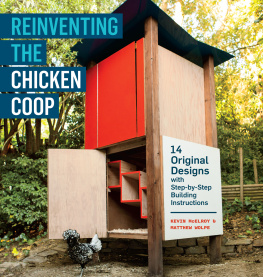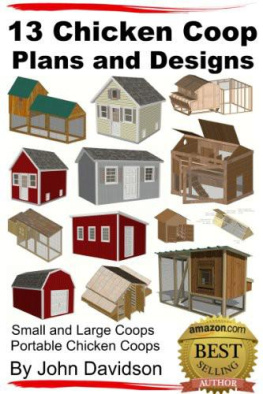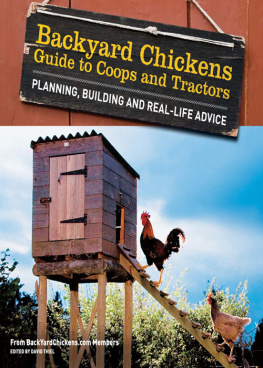How to Build a Chicken Coop
Learn How to Build a Portable, All-Season Chicken Coop in a Weekend

Need even more chicken coop plans? Click here now.
Copyright
By: John Miller
2013, John Miller
ALL RIGHTS RESERVED. This book contains material protected under International and Federal Copyright Laws and Treaties. Any unauthorized reprint or use of this material is prohibited. No part of this book may be reproduced or transmitted in any form or by any means, electronic or mechanical, including photocopying, recording, or by any information storage and retrieval system without express written permission from the author / publisher.
1. Introduction
As more and more people become concerned with the quality of food they eat, they are more often moving towards organic food supplies. But with good eating habits comes higher costs and that means a lot of us are left out of the loop when it comes to eating healthier foods.
Growing food at home is becoming an increasingly accessible option. Its not only a healthier option; its also a cheaper one too.
And its not just vegetables that are being grown at home. Chickens are making a huge comeback in peoples backyards for fresh eggs or poultry. Even urban areas have changed laws to allow homeowners to house small laying hens in their suburban backyard.
Chickens are one of the most affordable and easiest animals that can be raised at home. They require minimal maintenance, cost very little to feed and produce abundant eggs year round. Chicken eggs that are grown at home often have less fat content and higher nutrient counts than store bought eggsin some cases twice as much!
You dont need a lot of materials to keep chickens either. A specialty watering tray, food dish and nesting boxes are easy enough to get at any feed and farm supply store and typically cost less than $20 to purchase all of the supplies. A little fresh hay, yard leaves or tree clippings make for great nesting material and is all the materials needed for chickens to lay their eggs.
Food comes by the bag and is easily stored in a nearby shed or garage. Youll need a starter feed food for small chicks and an adult food to help hens so they produce plenty of eggs. Each bag will cost you less than $20 and will last three chickens about 6-8 months.
Chickens also eat bugs. If you have a bug problem in your yard or garden, you wont anymore if you own a portable chicken coop. Simply move the cage to the area in your yard you want them to scratch for bugs and theyll all be eaten in no time at all. Best of all, these bug eating birds help to create lawn roots, mulch leaves and till your garden.
With a portable chicken coop design, the bottom of the cage is open to the soil. This means that besides the healthy soil churning that chickens often create when feeding on bugs, they also help to fertilize the soil by digesting the bugs and excreting their dung onto the surrounding soil, helping the soil gain the much needed nutrients and minerals that plants need to flourish and thrive.
Many people assume that chickens will be loud. You dont need a rooster to have egg laying hens! Roosters are very loud and shouldnt be kept in rural locations in close proximity to neighbors. Pick up a few female hens and theyll lay eggs for years to come without so much as a few clucks and warbles. Hens sleep during the night and stay relatively quiet throughout the warmer parts of the day.
All in all, choosing chickens for your backyard is a smart, affordable and healthy way to maintain you and your familys nutritious diet. Get permission from your city officials, build your coop, buy your chickens and supplies, and then enjoy your chicken and eggs for years to come!
2. Overview
Small portable chicken coops are becoming more and more fashionable, not only for urban dwellers, but also for those living in the country. A smaller cage means less work and portability means you can use your chickens to fertilize your lawn or garden with ease.
But not all portable chicken coops are the same. There are literally hundreds of chicken coop designs all over the internet and in books, with each design having its own set of advantages and disadvantages.
With our A frame design, weve combined the best portable design features and created the ultimate portable chicken coop. This way, youll be able to have all of the fresh eggs you and your family can eat, without the troubles that sometimes come with other portable chicken coop designs.

All the fresh eggs you can eat!
Weve also designed our coop to be easy to assemble for beginning woodworkers. You wont need a lot of tools, skills or carpentry knowledge to build this great chicken coop. You also wont need a lot of money. Most supplies can be bought for around $200-$250 and maybe even less if you get a good deal from your local building supply store. Weve even included a few details on how to save even more money on your chicken coop so no matter what type of budget you have; you can enjoy a portable chicken coop in your own backyard.
As you can see in the photos, weve built our chicken coop inside. This is totally unnecessary and was just built indoors for photo clarity. Build your chicken coop directly onsite and you wont have to tote it around as far. You wont even need power if you rip and cut the boards near a power source first, and then move the materials to the site for assembly with a battery powered screwdriver.
But before you start; its important to find out if its OK to have chickens in your neighborhood. Obviously if you live in the country, its a good bet that you can have chickens. But for more urban landscapes, its always important to check with local building and health department officials to find out if its legal to keep chickens in your area.
Chickens need excellent ventilation when it comes to being kept in a coop. While this coop is designed for maximum air flow, if you live in an area where heat is a problem, you may want to add a few long wooden dowels into the cage. This will allow the chickens to fly up to the elevated dowels and roost. This is how chickens help to keep themselves cool during the day and night.
This chicken coop is designed to house up to three chickens comfortably. If you would like to keep more chickens, simply double the overall length of the coop and you can easily house 6-8 chickens with ease. You can also double the height or width to allow more chickens into the coop. But with a larger design comes more weight. If youre concerned about the weight when you need to move the cage, you may want to add wheels to the coop to allow it to roll easily from place to place.
3. Tools
For basic woodworking projects like building a chicken coop, its a good idea to have a wide assortment of tools on hand. But if youre a beginning woodworker and you have a limited supply of tools, you can still build this portable chicken coop. In some cases, you may want to buy some of the following less expensive tools or you may want to rent some of these tools if they are out of your price range. Use the following list of tools to make sure youve got what it takes to get this job done quickly, safely and correctly.
- Circular Saw- This is one of the most versatile cutting tools available for ripping and cross cutting alike. Its mobile design allows you to cut materials out in the field with ease. If youll be using this tool for ripping down stock materials, you may want to purchase a ripping blade designed just for a circular saw to help keep blade revolutions high and motor temperatures low.








